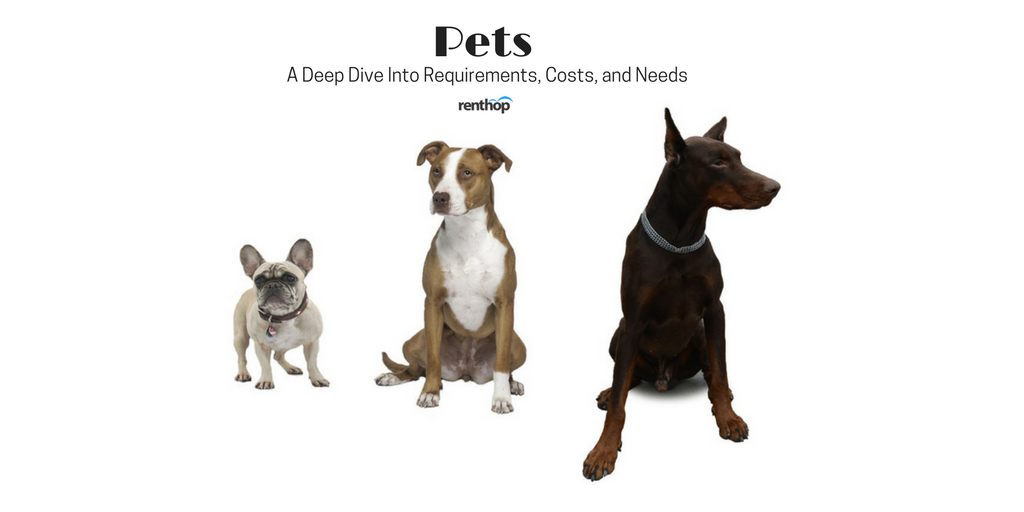
According to ASPCA (2015-2016), approximately 44% of all households in the US have a dog and 35% have a cat. Having a pet is a big responsibility. Adding a pet to the equation when living in a big metropolitan area, makes it even more of a responsibility. Not only do most big cities not offer a big backyard for the pet to explore when you’re at work, but pet owners can also be met with restrictions when renting apartments, such as no pets allowed, weight restrictions, and breed restrictions. Some common reasons for the restrictions might be because pets can cause property damage, other tenants can file noise complains, and it can lower the overall value of the building. Finding an apartment that allows pets, or specific breeds can be a difficult and daunting task, and always easier if you’re opting for the option of buying over renting.
Based on our key findings, we find the following four recommendations helpful, especially if you’re considering getting a pet in a big city:
- Opting for the smaller size pet to work with the weight restrictions.
- Recommendations, documentations, and pet resumes. Make your pet look good through recommendations from previous landlords and documentations that show your pet is healthy.
- Expanding your search as a longer commute opens up more possibilities. This will lower rent and you’ll most likely find more landlords willing to accept different breeds and sizes.
- Look for independent landlords especially if you are looking to get a dog from the commonly banned dog breed list.
This study includes the following sections:
- Part One: Breaking Down the Requirements
- Part Two: The Costs of Having a Pet
- Part Three: Interest Over Time for Pets (National Trends)
Part One: Breaking Down the Requirements
What kind of pet can I have in an apartment?
We know “no pets allowed” means no pets in the apartment building. But how strict is that and what animals does it apply to? That depends on the apartment building and the landlord. It should be specified in your lease what kind of pet is allowed and not. For example, you would probably think the “no pets” policy wouldn’t apply to fish as they don’t take up too much space nor can they be considered noise disturbance. While a single fish in a small fish bowl probably won’t be a problem, a large fish tank might be frowned upon. An apartment building or landlord will be more reluctant to accept animals that can be a liability to their property. In the lease, there should be a pet clause confirming which animals are allowed, the number of pets allowed, and any other circumstances around the pet.
What breed and weight restrictions apply?
When it comes to breed and weight restrictions, this usually applies more to dogs than cats. First of all, before getting a dog, it is recommended that future pet owners do thorough research into the breed that would best fit their lifestyle. Getting a dog that requires a lot of exercise wouldn’t be the best fit for a household that is minimally active. The same research should be implemented toward what dogs are best for what kind of apartments. Some dogs do well in apartments, others need more space than for example a studio or 1 bedroom apartment. According to the American Kennel Club, the dogs listed to the left are the dogs that are best suited for apartment living, based on reputation, size, and personality. The dogs listed to the right are dog breeds that are commonly banned from apartment buildings based on reputation, size, and personality.
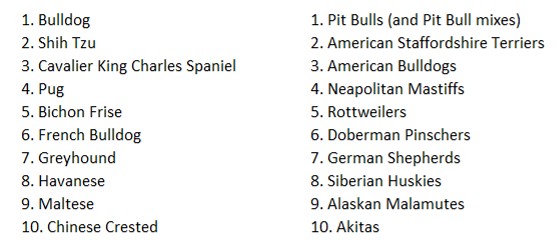
These are just some dogs that are mentioned as being a good fit for apartments and vice versa. There are of course other breeds that other landlords might frown upon or that do well in apartments. Alongside being aware of certain dog breeds that are commonly banned from apartment buildings, another obstacle is weight restrictions. Usually, renters are met with a weight limit of 20 – 50 pounds. This immediately limits most of the bigger size dogs from the commonly banned list above.
Can I have more than one pet?
Again, this is up to each landlord. Some might be ok with more than one pet in the apartment, while others are not. This can differ from one building’s pet policy to another. If you’re considering getting more pets eventually, make sure it is specified in your lease the number of pets allowed. Independent landlords might also be easier to convince about having more pets than just one in the apartment.
Part Two: The Costs of Having a Pet
How much will a pet cost you, rent-wise?
The size of the pet will usually determine the size of your apartment. While bigger apartments with a lot of space will be the best option for any pet, not all pets necessarily need their owners to have a massive house or even a 2 bedroom apartment. The need for an apartment with a certain number of square feet to fit the pet is something you need to think about. Cats are always easier, as they don’t take up as much space as a dog. While cats are usually similar in size, dogs come in all different sizes ranging from small to extra large if you will. While the size of the dog might not necessarily mean you have to get a massive apartment, the size does matter. And so does the energy level of the dog breed. While a lot of bigger dog breeds do just fine in an apartment, their energy level might be lower than a smaller, high energy dog breeds. It is not so much about the size of your dog as it is about their personality and needs. Having a high energy dog cooped up in an apartment that is too small for them, will make your dog and your furniture miserable.
When we wrote the study, “The features that are increasing your rent”, we found that having a pet would increase your rent. How much, exactly, differ by city. The rent in the following cities increased with the following amount if renters were looking to find pet-friendly apartments for rent:
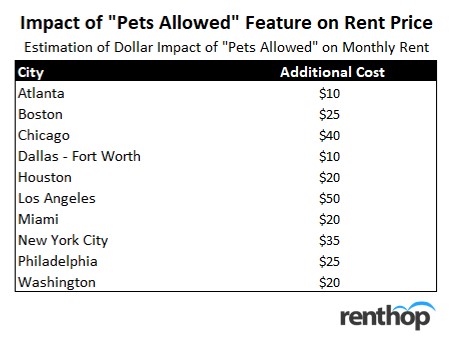
It is not uncommon that certain features will increase your rent. While “pets allowed” isn’t the most expensive feature, it is nevertheless a feature that will spike up the rent a bit. Pets being considered a liability by most landlords, due to the reasons listed above, could be why.
How much space does a dog need?
There is no straight answer for how much space certain dog breeds need. Just because a dog is bigger in size, doesn’t mean he or she won’t do well in an apartment and vice versa. However, for a bigger dog, it might be nice to have more space for them to roam. Especially if the dog is known to have a high energy level. People say smaller dogs are better for apartments, so we decided to take a look at the different breeds and their traits, to see if that was true.
We provided higher points for traits such as small in size (weight and height) and fewer points for dog breeds that went over the usual 20 – 50 pounds weight limit and so on. We also gave fewer points to dogs that are very active, as these dogs need a lot of room if you’re looking to rent, while the barking level only ranged from “quiet” to “barks when necessary”. Basically, we gave higher points to breeds that didn’t possess traits that would be viewed as less of a liability from a landlord. This is not a scoring of what breed is better for apartments, rather what traits could be viewed as a problem for apartment living. Below are the results:
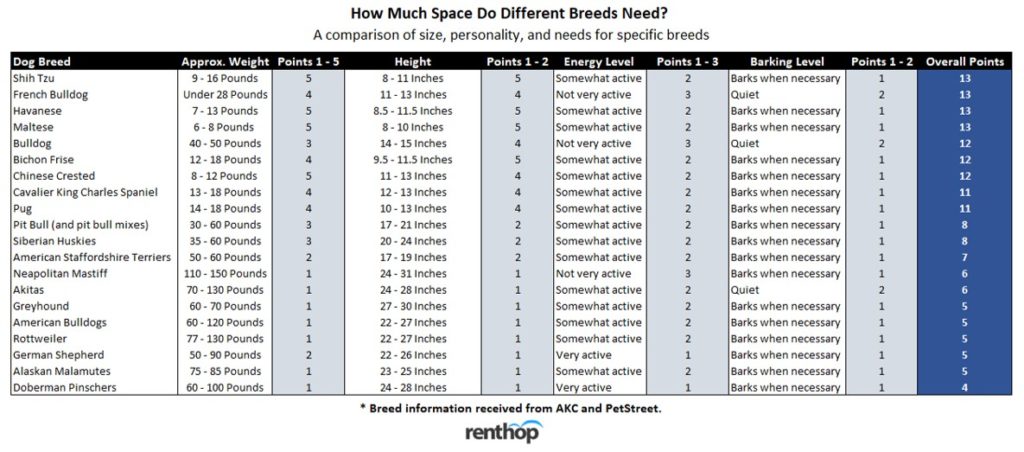
The highest a dog breed scored was 13 points, while the lowest was 4 points, based on traits that could be viewed as a liability to a landlord. The score ranges from 1 to 13, with 13 being viewed least likely to be viewed a liability to a potential landlord. It is not surprising that the smaller dogs are ranked highest as dog breeds that don’t pose that much of a liability to landlords. Smaller dogs are also a good fit for apartment living, but remember that size is not the only factor that determines if a dog is fit for apartment living. High energy dogs, no matter the size, need a bigger outlet for releasing their energy. So how much, approximately, could each of these dog breeds cost you in rent?
First, we would need to know the median rent by the number of bedrooms by the selected cities. We used the same median rents as we used from the study, “The features that are increasing your rent”. We already know that the bigger the apartment the more it will cost us in rent. If you’re just thinking of getting an apartment for yourself, you would be fine with a studio apartment. But would you need to upgrade to a 1 bedroom based on the dog breed you get? Let’s explore. Using the table that shows how a dog would roughly score based on certain factors that a landlord could view as a liability, combined with the median rents for the different cities, we came up with a rough draft for how much certain dog breeds could end up costing you in different cities. We put dog breeds who scored 11 – 13 points as being suited for a studio apartment. Dog breeds who scored 6 – 8 points in a 1 bedroom apartment, and dog breeds who scored 4 – 5 points in a 2 bedroom apartment. Below are the results:
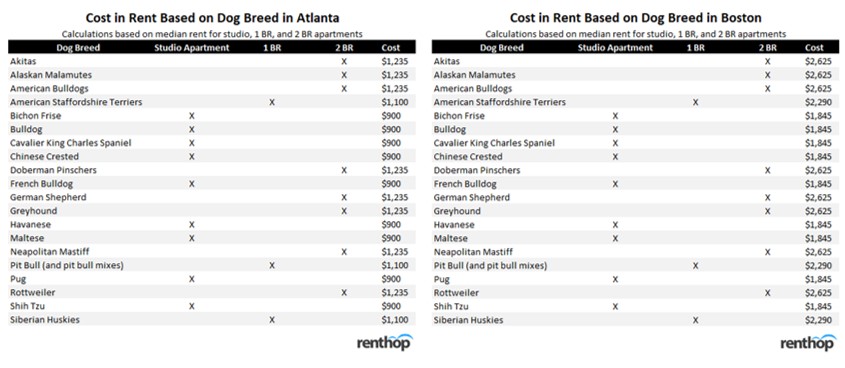
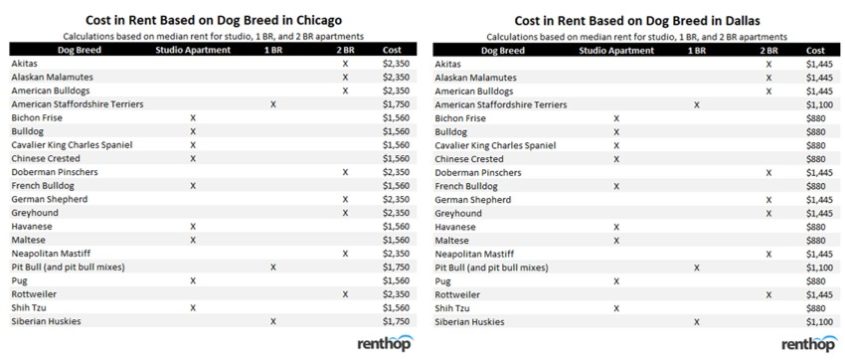
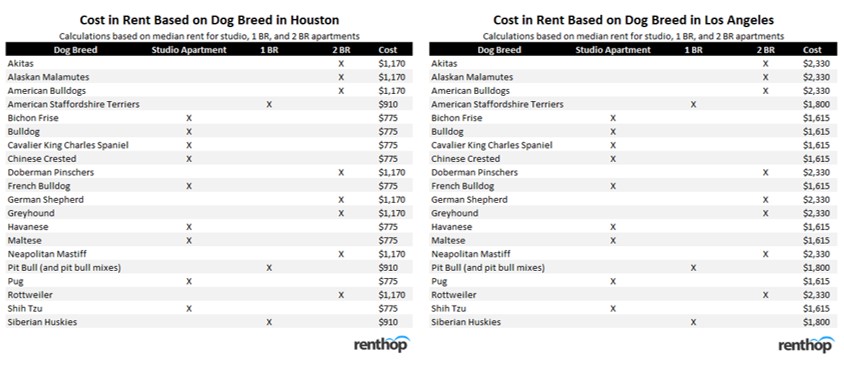
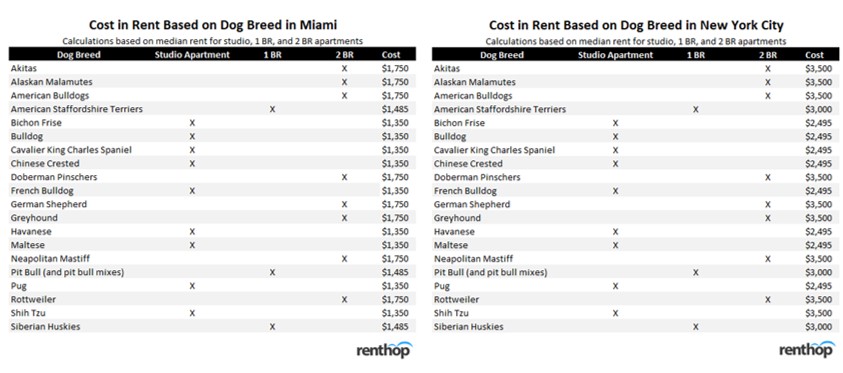
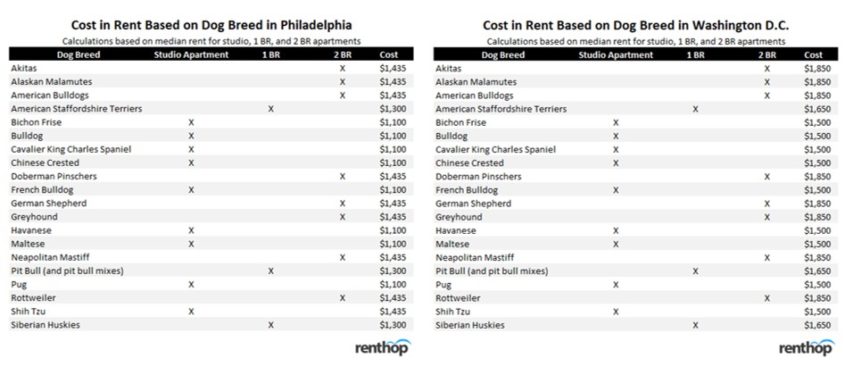
Again, this is a rough calculation. While dogs have certain traits, they are also like humans in the way that they have different personalities. Some dog breeds that are known for being highly energetic might actually prefer to sleep most of the day. But to give us an understanding of how much a dog breed could end up costing you in rent, the above tables for the different cities could be a good indicator.
One can also do a quick calculation, by breed size only, on how much a dog breed could end up costing you in rent. By dividing it by size only, let’s categorize dogs into the category small, medium, and large. You can find out exactly how much your dog could end up weighing by looking at this chart from AKC. Then roughly say that you should consider a small dog for a studio apartment, a medium sized dog for a 1 bedroom, and a large dog breed for a 2 bedroom apartment. (Obviously, this is just a rough calculation of how much you could end up spending on rent. You would only know after knowing the exact dog breed, their energy level, and their needs). This would roughly tell you how much you could end up paying in rent. So, when looking at the median rent per city (also remember to add the additional pet fee per apartment listed further up), you should have a good understanding of how much you would be paying in rent based on your pet. See how much the different dog size could cost you by apartment size in different cities below:
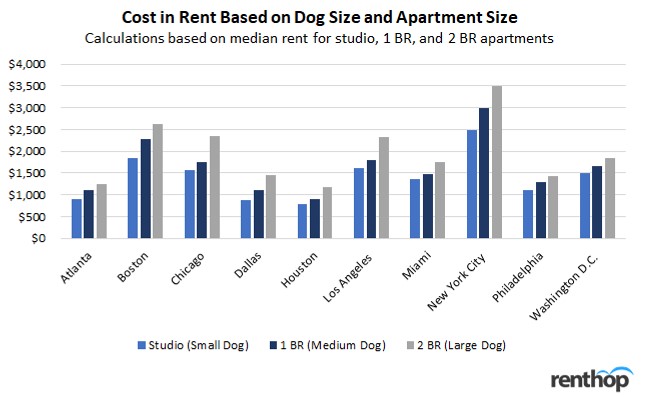
Having a bigger dog in New York City would end up costing you more in rent if you were to follow the 2 bedroom apartment for a large dog hypothetical. The median rent in Houston is the lowest for all of the cities selected, across all three apartment sizes. Technically, if one followed the logic listed above you would be able to fit a large dog in a 2 bedroom apartment in Houston for less rent than it would cost to have a small dog in a studio apartment in New York City. Rent in New York City, and other big cities, are known for being notoriously high. This leaves us thinking that maybe most people, in cities where rents are high, opt for a smaller pet if a pet at all.
What are some other pet-related costs you need to budget for?
When getting a pet, there are more things you need to budget for than just food. Here are just a few things you will be spending money on:
- Food, treats, and toys.
- Vet visits/medical bills.
- Health insurance.
- Pet license.
- Pet deposit/pet fees for allowing pets in the apartment building.
- Renters insurance/home insurance.
We were also curious to see what the national trends were when it comes to pets and apartments. Specifically, we were interested in seeing the interest over time for pet-friendly apartments, if there is a correlation between interest and months, and which search term seems to be the most popular over time. We turned to Google Trends to help unveil the answers to the questions above for trends, looking at the data from 2004 and up till now. We followed the Google Trends’ metrics when making comparisons and assumptions. Google Trends scores search queries from 0 to 100, with the value of 100 being the most commonly searched query, 50 being a query searched half as often, and so on.
Part Three: Interest Over Time for Pets (National Trends)
Like mentioned earlier in the article, approximately 44% of all households in the US have a dog and 35% have a cat according to ASPCA numbers from 2015 – 2016. This, however, doesn’t tell us what households are renting versus buying. Which is why we turned to Google Trends to see what the trends were for specific renting questions.
Interest over time for pet-friendly apartments
Looking at the table below, it is rather clear that there has been a steadily increased interest in pet-friendly apartments over the years, with 2017 being the year where the interest has been at its highest. Taking a deeper look at the numbers, we also get an understanding of which months the search term “Apartments for rent pet-friendly” is the most popular over the years.
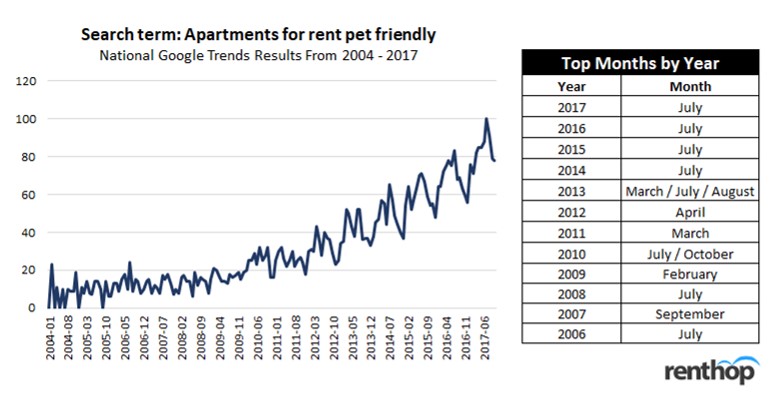
*** Note: The data from 2004 and 2005 were excluded as the years had partial to incomplete data available.
By looking at the months where the search term “Apartments for rent pet friendly” was the most popular, we can make the comparison that more people seem to be looking for pet-friendly apartments around the summer months over the past years, which makes sense as the rental market tends to tighten around that time of the year as well. This also raises the question: Do landlords set “no pets allowed” because they know more people are looking for apartments around the Summer?
The more popular pet: cats vs. dogs
When people get pets, the decision usually stands between getting a dog or a cat. So we wanted to see if there was any difference in what people searched based on those two animals as pets when it comes to animals and apartments.
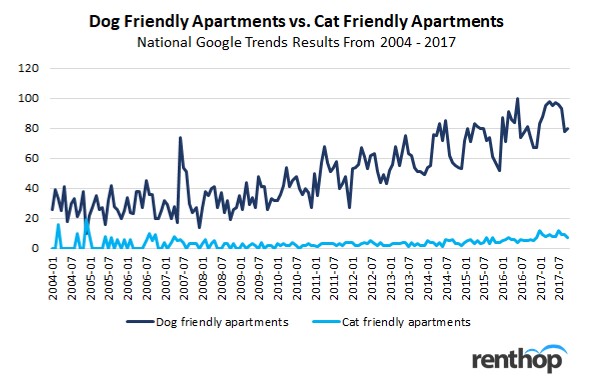
By looking at the table, it is clear that more people on a national level search for dog-friendly apartments than cat-friendly apartments. Does that automatically mean that more people want dogs over cats? Not necessarily. Apartment buildings might specify that dogs are not allowed, as dogs are usually bigger and louder than cats, making landlords view dogs as more of a hassle than cats. Also, there are specifications as to what breeds are allowed in certain buildings as mentioned in the introduction. An example being Pit Bulls, who are widely known for having a bad reputation. When we did the same comparison but added the search term “Pet friendly apartments”, pet-friendly apartments won over both dog and cat-friendly apartments, as seen below.
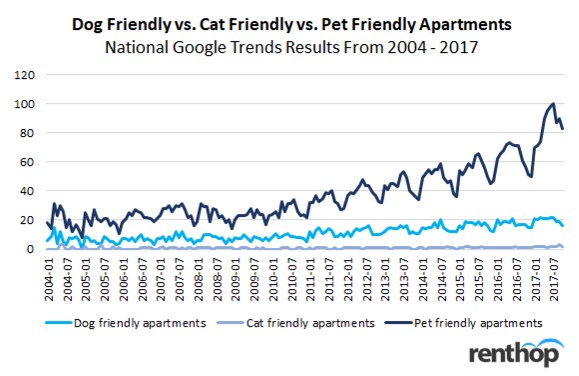
The table on above makes it clear that the search term “Pet friendly apartments” is the more commonly searched term of the three. This makes sense, as more often than not, apartment buildings do not specify between cats or dogs but more do specify between pets allowed in the building. However, what is interesting about the data is how popular the search for pet-friendly apartments has become over the years. This raises the question, are more people getting pets, or has it become more difficult to find an apartment that allows pets?
***
Getting a pet is a big responsibility. Before even considering getting a pet, you should make sure you have the resources to have a pet, such as a big enough apartment for your pet’s needs and the money it would cost you to have a pet. Owning a pet is like having a baby. Budget for the known costs and be ready for worst case scenarios. Just like kids, animals can get into accidents. Make sure you’re able to cover the costs of any unexpected bills and vet visits before getting a furry best friend.




